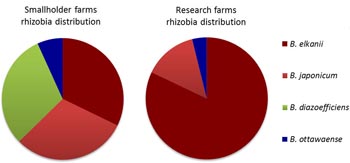Mazvita Chiduwa is pursuing her studies for a PhD at Murdoch University. She commenced in July 2012 under the supervision of Ravi Tiwari, John Howieson, Julie Ardley, Graham O’Hara and Paul Mapfumo.
Soyabean is grown throughout Zimbabwe and is recognised as a strategic crop because of the myriad of benefits accruing. Although indigenous rhizobia have been isolated, distribution is highly erratic and inoculation is critical to obtain economic yields in Zimbabwe. Currently and since the 1960’s inoculation is achieved with the elite soyabean inoculant Bradyrhizobium diazoefficiens MAR 1491 (=USDA 110T) and MAR 1495 (=USDA 122) supplied as inoculant sachets by the Soil Productivity Research Laboratory, where Mazvita has worked since 2005. These exotic strains have been reported to exhibit limited saprophytic competence while indigenous soyabean nodulating rhizobia are hypothesised to display superior environmental adaptation.
 |
In the present study the diversity of 138 authenticated root nodule bacteria obtained from six sites in Zimbabwe was evaluated. Three of the sites were soyabean-breeding facilities which use research led recommendations including fertilizers, their rates and breeder’s seed and the other three were smallholder-farming communities that generally practice low external input agriculture including reduced fertilizer rates and manure, to account for the dualistic farming system in Zimbabwean agriculture. |
Isolates were trapped with soyabean under glasshouse conditions using soils obtained from the breeding facilities while those from communal farmers were isolated from soyabean nodules obtained directly from the fields.
The phylogeny of the isolates has been evaluated. The isolates have been evaluated for their nitrogen fixation potential under glasshouse conditions. Host range analysis has been carried out for representatives of the species identified.
All 138 isolates were slow growing and formed either dry colonies (%) or wet mucoid (%) colonies. Based on multi-locus gene sequence analysis (MLSA), the majority (61%) of the strains recovered belong to Bradyrhizobium elkanii species whilst B. japonicum accounts for 21%. The newly identified species recovered from soyabean in Canada, B. ottawaense, was also recovered although it only accounted for 5% of the isolates. Only 13% of recovered isolates identified with the previously inoculated B. diazoefficiens strains. Interestingly, none of these were recovered from research facilities, suggesting that the higher input systems promote indigenous rhizobia at the expense of the elite, exotic strains. Using host range analysis across fourteen legumes in the glasshouse, a nodulating pattern across four legumes (G. max, P. vulgaris, C. juncea and V. radiata) distinguishes the four species. A PCR-based multiplex method to distinguish the four species based on their recA gene sequence has also been established. A further 25 root nodule bacteria have been isolated from trap soyabean in soils obtained from two virgin soils and one agricultural field that has not been inoculated to understand the phylogeny of the indigenous soyabean nodulating rhizobia. The species identity of the indigenous isolates will be established using the multiplex method.
All isolates were compared for their nitrogen fixation efficiency under glasshouse conditions. The inoculant strain MAR 1491 was used as a standard against which all strains were compared. The top 27 isolates were compared in a further experiment. The most efficacious isolates are highly similar to B. diazoefficiens. B. elkanii also generated high top dry weights in the inoculated plants and only one strain from the B. japonicum was comparable to the inoculant strain. Finally six strains were compared for their nitrogen fixation across three Zimbabwean soyabean cultivars Mhofu, Status and Pan 1867. The results of this experiment will be used to make recommendation for inoculant strains to be used in Zimbabwe.
Mazvita Chiduwa*, Murdoch University, Australia
* Mazvita won the best translational research poster prize at last year’s Poster day held in the Veterinary and Life Sciences School. To this poster we link here.
